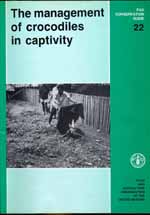

2. CROCODILES AS FARM ANIMALS:BIOLOGICAL CHARACTERISTICS
2.1 Body Temperature
2.2 Breathing
2.3 Feeding and Growing
2.4 Reproduction
2.5 The Senses
2.6 The Skin
4.1 Life and Death in the Wild
4.2 Captive Rearing: Increasing Nature's Yield
4.3 Captive Breeding
5. COLLECTION AND INCUBATION OF EGGS
5.1 The Optimum Time for Egg Collection
5.2 Location of Nests
5.3 Estimating the Stage of Incubation from the Eggshell
5.4 Estimating Stage of Incubation from the Embryo
5.5 Collecting the Eggs
5.6 Incubation
5.6.1 Incubation Using Artificial Nests
5.6.2 Powered Incubators
6.1 Post Hatchling Problems
6.2 Basic Needs
6.3 Enclosures For Hatchlings6.3.1 Dimensions and Stocking Density
6.3.2 Layout and Design
6.3.3 Water Supply
7. CAPTURE, TRANSPORT, MARKING AND MEASURING OF YOUNG WILD CROCODILES
7.1 Capture of Young Wild Crocodiles
7.2 Transport
7.3 Marking and Taggging
7.4 Weighing and Measuring
8. ENCLOSURES FOR CROCODILES UP TO CULLING SIZE
8.1 Location of Enclosures
8.2 Pen Size and Stock Density
8.3 Fences and Fence Materials
8.4 Earth Pools
8.5 Concrete Pools
8.6 Vegetation and Shade
8.7 Feeding Surfaces
8.8 Isolation Pens
8.9 Water Supply
9. FEEDING AND GROWTH OF JUVENILE CROCODILES
9.2.1 Diet
9.2.2 Size
9.2.3 Species
9.2.4 Sex
9.2.5 Individual Variations